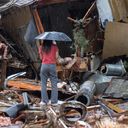Deadly storm pummeling California dumps historic rains over LA

Heavy rainfall and mountain snow from a "dangerous" atmospheric river slamming Southern California that brought a rare "high risk" of potentially deadly flooding in Los Angeles County this week is set to linger until at least Thursday.
The big picture: The storm that rapidly intensified Sunday off California's coast has resulted in at least four deaths and disrupted travel across the state. City of Los Angeles crews have responded to 383 mudslides, and there have been multiple road closures and water rescues across the state due to flooding.
Here are the latest details for the rest of the storm. An end is in sight, but not until Thu or Fri. Do not let the break Wednesday morning misguide you - more rain and mountain snow coming Wednesday afternoon and night. #cawx #larain pic.twitter.com/GaK8SUp63H
— NWS Los Angeles (@NWSLosAngeles) February 7, 2024
State of play: A fire hose of moisture from the strong atmospheric river, likely worsened by climate change, continues to be directed into the LA Basin, as the moisture from the weather system responsible for the flooding expands into the Southwest.
- Small hail was observed as moderate to heavy showers expanded over Ventura and Los Angeles County Tuesday evening, per the National Weather Service's LA office, which warned: "Expect roadway flooding and strong flows in creeks. Slow down on the roads."
- The storm may dump hefty snow totals all the way into the Rockies.
Of note: UCLA climate scientist Daniel Swain said during a briefing Monday that this storm "in LA specifically" has been an "utterly historic rain event."
- The White House said in a Monday statement President Biden pledged to help with all federal support requested during a phone call with Los Angeles Mayor Karen Bass and California Gov. Gavin Newsom — who declared an emergency Sunday for eight southern counties, including LA.
Threat level: Some 30 million California residents were covered by flood alerts on Tuesday.
- There were numerous reports of landslides and flooding in the Hollywood Hills, Santa Monica Mountains and Beverly Hills.
- Multiple locations in the LA Basin had exceeded 11 inches of rain Tuesday, with additional rain having fallen since.
There was another inch of rainfall yesterday after my prior post taking the 2-day (Feb 4-5) total @UCLA to ~12.8". Today's rain takes this storm over 14".
— Chad Thackeray (@ChadThackeray) February 7, 2024
Thus after only 6 days, February 2024 is already the 5th wettest month(!) for Westwood since 1933. #LARain #CAwx https://t.co/EwgMFCMz1h pic.twitter.com/Sj6zdWujDv
By the numbers: Rainfall totals of 4 to 8 inches, with some spots seeing 8 to 14 inches, constitute months' worth of rainfall within three days.
- In Los Angeles County, 12.32" of rain had fallen in three days as of 11am local time Tuesday in Bel Air and 8.13" in downtown LA, per the NWS. Downtown LA received 4.10 inches of rain on Sunday alone, tying as the 10th-wettest day on record there.
Zoom in: Winds have lessened from Sunday's howling hurricane-force gusts that felled trees and saw the FAA implement ground stops for aircraft headed to San Francisco International Airport multiple times.
- At 12:45am Wednesday local time, an estimated 80,000-plus customers in California were without power — down from Sunday's peak of over 900,000.
Between the lines: One of the most difficult aspects of the forecast has been predicting where the heavy rain would slow. This was initially expected to take place in the mountains of Ventura, Santa Barbara and LA counties, but instead it happened over the LA Basin.
- The atmospheric river itself is unusually strong for Southern California, with a forecast discussion Sunday night noting that moisture in the atmosphere was 3 to 5 standard deviations from normal.
The intrigue: The atmospheric river, a narrow highway of moisture at mid-levels of the atmosphere, will be aimed at the California coast for a prolonged period, sliding from north to south over time.
- This air contains a tremendous amount of water vapor, which is enhanced by unusually high sea surface temperatures between California and Hawaii.
- "The warmer the surface ocean is, the more potential evaporation there is off of it," said Swain, who added human-caused climate change and El Niño were likely causing this year's trend.
Avoid crossing flooded roadways. #TurnAround #staystorminformed #SloCountyFire pic.twitter.com/kLkn4ApQSI
— CAL FIRE SLO (@CALFIRE_SLO) February 6, 2024
Zoom out: A warming environment is making extreme precipitation events more common and intense across the U.S. and the globe and is predicted to make atmospheric rivers even wetter in coming years.
- One 2022 study found that atmospheric rivers that hit California in 2017 were up to 15% wetter due to human-caused climate change, indicating such an influence may already be detectable.
- Other recent studies have found similar conclusions.
The bottom line: This storm is far from over, and is likely to rank among the most intense to hit the state in years.
Go deeper: The biggest factors behind California's historic flooding
Editor's note: This article has been updated with new details throughout.